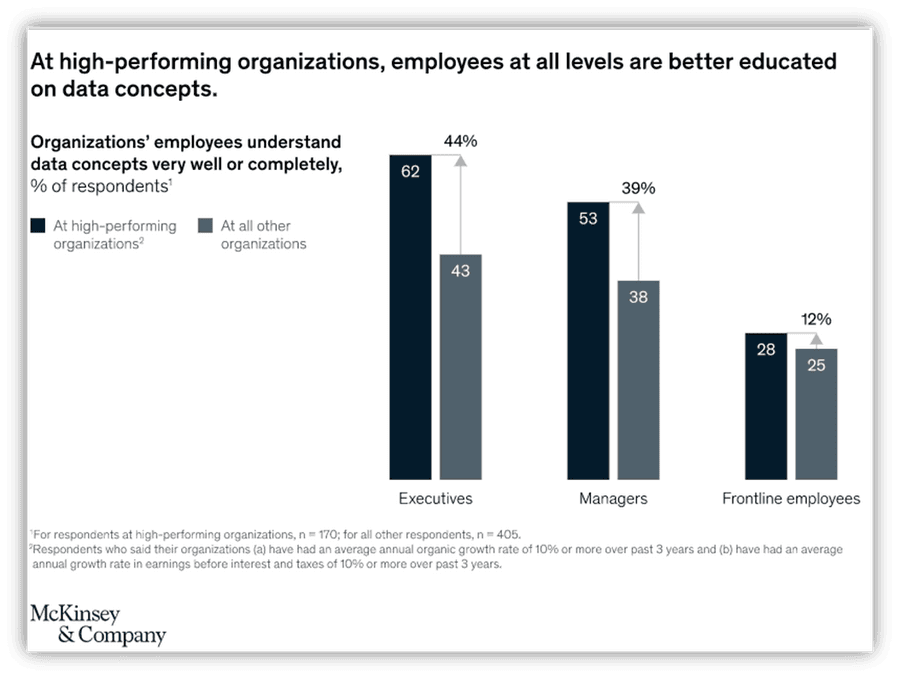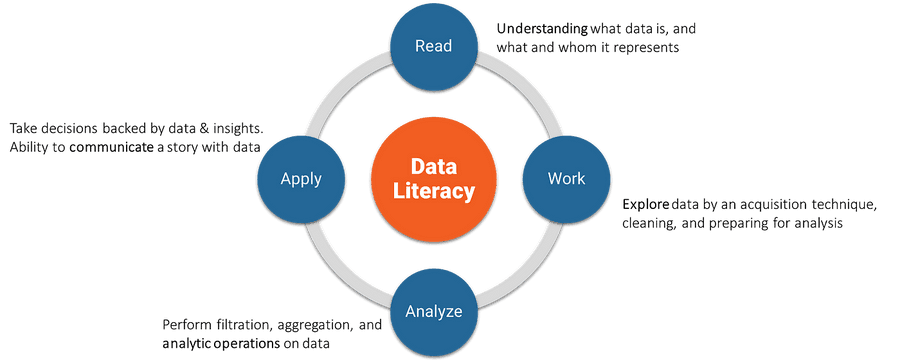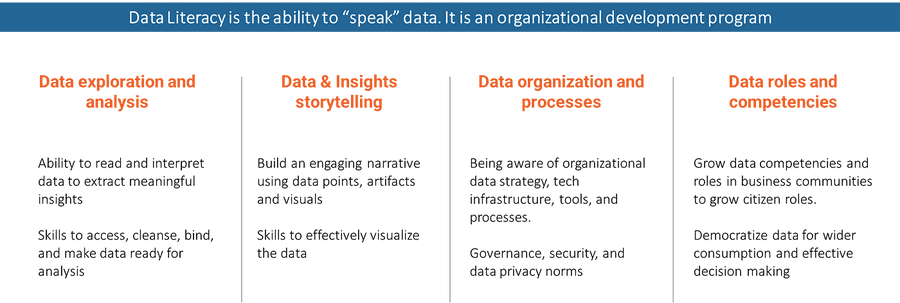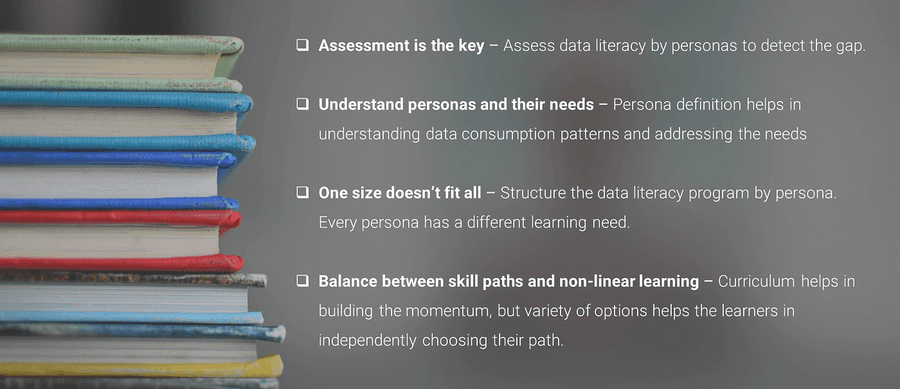6 steps to build Data Literacy program
Curated from: codex-dc.medium.com
Ideas, facts & insights covering these topics:
17 ideas
·571 reads
2
Explore the World's Best Ideas
Join today and uncover 100+ curated journeys from 50+ topics. Unlock access to our mobile app with extensive features.
The dangers of waiting too long are that someone else will do it first, and better
JENNIFER BELISSENT
9
86 reads
Getting Insights From Data
Organizations are sitting on torrents of data; they just need right acumen to extract insights and be data-driven.
Most business leaders still rely on their experiences and gut feeling when making business decisions , a report by forester surveys shows that 48% of decisions today are completely based on quantitative information and analysis. A lack of data literacy skills obstructs the transformation into an insight driven organization.
8
73 reads
Data Literacy
The organization who understands their customer well can serve them better and who understands the process can improve them. Data and analytics can help but only when well understood across the entire organization and used effectively.
Data literacy is the ability to read, write and communicate with data which includes deep understanding of data sources, analytical methods and techniques applied to turn raw data into meaning insights which can help in validating the decision with data and hence add value to an organization’s existing capabilities.
8
64 reads
Making Sense Of Data
The ability of understanding and communicating with data language is a core skill required today. The art of successfully driving value from data and analytics is a core competency for making an organization stand out and leaving the competitors behind.
Data literacy is an underlying component of digital dexterity, which is defined as an employee’s ability to use existing technology to drive better business outcomes.
9
50 reads
Importance Of Data Literacy
Poor data literacy is ranked as the second-biggest internal roadblock to the success of the office of the chief data officer. By 2020, 80% of organizations will commence development in the field of data literacy to overcome extreme deficiencies, 50% of organizations will lack sufficient AI, data science and data literacy skills to achieve business value.
As organizations become more data-driven , poor data literacy will become a deterrent to growth.
8
37 reads
What Organizations Can Ask Themselves
● How many people aligned with your business do you think can interpret straightforward statistical estimations such as correlations or averages?
● How many managers can construct an optimal business case based on available data and relevant numbers?
● How many managers can access the output of their systems or processes?
● How many data scientists can explain the output of their machine learning algorithms?
8
29 reads
Strategizing Data Literacy
Start by identifying the data speakers within the organization’s i.e., Business analyst, data scientist or architecture who can speak with data as they serve as a good mediator in incorporating data driven culture within the organization. Organizations can also identify the gaps where data isn’t utilized to its full potential and can conduct data literacy workshops, training, assessments for smooth induction of data literacy.
8
27 reads
Incorporating Data Literacy Program Step 1: Planning and Vision
For most of the enterprises, the data literacy program starts with a discussion drive between the data officer, competency managers, and the people leaders. The discussion should cover three critical aspects i.e., the participants, duration & budget, and the time needed to complete the program.
8
29 reads
Step 2: Communication
Data Literacy is a workplace transformation program, not a technical training. Therefore, keep a note to communicate and communicate more.
i. Communicate the program objectives
ii. Communicate the benefit on personal & professional growth and productivity
iii. Communicate the trends by drawing industry parallels, case studies, and testimonials
iv. Communicate the examples set by the leadership
v. Communicate and broadcast the internal stories
8
22 reads
Step 3: Workforce Assessment
A simple assessment will reflect the level of understanding of the workforce.
- Data Learner — He has heard about data and is willing to grow in the field, but lacks subject knowledge
- Data Apprentice — Comes with a basic level of expertise in data handling and analysis.
- Data Journeyman — Works on routine data activities like data collection, processing, and basic analysis
- Data Star — Expert in handling all stages of data lifecycle management — data collection, processing, and analysis.
- Data Rockstar — Has the ability to build stories with data and communicate to business stakeholders.
10
21 reads
Step 4: Culture Discovery
Learning is a habit and habits build culture. Organizations who have successfully implemented data literacy programs have a culture of learning and growth. Data literacy is not meant for the workforce to perform better in their projects, but it is to build habit of critically analyze data to make better decisions. Now here comes the tough part — why should we learn? Resistance, push back, and interrogation eats a lot of time and patience.
9
18 reads
Step 5: Prescriptive Learning
The prescriptive learning is designed based on the different levels of data literacy; this roadmap helps in ensuring that no learner feels lost trying to absorb the concept or is bored by wasting time. The success of the program largely depends on devoted learning time in daily schedules incorporated with consistent assessments and feedback for improvement.
8
20 reads
Step 6: Impact measurement
The data literacy program should have a preset success criteria that can be visited in due course of time to get a glimpse of the program on the ground and if needed, calibrate the program strategy. The metrics can be sign up, active users, program completion, and very importantly rewards & recognition.
8
14 reads
Challenges With Data literacy training programs:
The growth of organizations solely depends on how the leaders responsible for incorporating data literacy in organization think about the data literacy program, data literacy is not equivalent to data training and it’s all about how effectively they plan the programs within organizations.
The plan for making a common data literacy program for everyone regardless of their previous experience, knowledge, skill set or role in the organization. For example, a data leader might have a different learning needs, while business stake holder might have a different ask.
8
21 reads
Data Literacy Training Is Made Up Of MOOCs
MOOC (massive open online courses) platforms offer numerous knowledge tracks and there is nothing wrong in adopting them. However, data literacy is best learned when you have data, an exploration tool, and a simple problem statement to chase. Instead of just reading the scripts, you will see the problem through data lens.
Remember data literacy is about learning skills which will help you more than anyone else.
9
14 reads
Training Does Not Include Use Cases
Another common mistake which organizations make is to equate training with data literacy, it is not an easy skill to learn if it doesn’t include use cases and it is likely to be forgotten after some weekends. Mentoring employees while they apply their learning on use cases will help them build effective skills for the longer term, and for achieving the best data literacy outcome employees should immediately apply what they learn in their current workflow.
9
20 reads
The Conclusion
Data literacy is a requirement for making effective insight driven decisions, with short term investment in the program, data tools the organization can democratize data. Successful data literacy programs can play a significant role in creating long term business growth when coupled with right executive support, strategic goals, and established metrics.
9
26 reads
IDEAS CURATED BY
Miles 's ideas are part of this journey:
Learn more about computerscience with this collection
Identifying the skills needed for the future
Developing a growth mindset
Creating a culture of continuous learning
Related collections
Similar ideas
8 ideas
Leadership disrupted: Pushing the boundaries
www2.deloitte.com
2 ideas
Read & Learn
20x Faster
without
deepstash
with
deepstash
with
deepstash
Personalized microlearning
—
100+ Learning Journeys
—
Access to 200,000+ ideas
—
Access to the mobile app
—
Unlimited idea saving
—
—
Unlimited history
—
—
Unlimited listening to ideas
—
—
Downloading & offline access
—
—
Supercharge your mind with one idea per day
Enter your email and spend 1 minute every day to learn something new.
I agree to receive email updates










